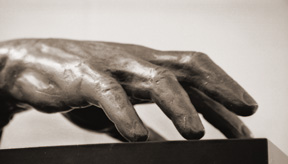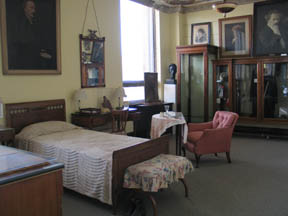PIANIST AND COMPOSER

The mould of Paderewski's hand
Ignacy Jan Paderewski`s contemporaries often referred to him as the greatest piano player since the time of Liszt. His piano career lasted more than 50 years. The artist became widely known and admired after his Paris debut in Salle Erard in March 1888. In both Paris and London he was declared the greatest artist since the time of Chopin. Paderewski`s first American tour in 1891 reinforced his worldwide fame.
European royalty attended his public concerts. He performed numerous private concerts for Queen
Victoria of Great Britain. He toured in Europe, North and South America, Southern Africa, Australia, New Zeland, and Hawaii. The Polish piano player became a “star” and the most admired virtuoso of his time, and his artistic reputation is the same today.
After his first London concert in St. James Hall on May 9, 1890, Paderewski received overwhelmingly negative reviews from the English critics. He was criticized for mannerism in his piano play and sentimentalism in the pieces he composed. He was even referred to as the “blacksmith of the piano”. Soon, the positive opinions about the pianist and the delight for his talent outweighed the negative criticism he received. Paderewski`s tour throughout Great Britain attracted large crowds at every stop. After his successes in Europe, he decided to conquer the American audience. In spite of the artist`s “struggle” with huge American Steinway instruments, which were less delicate and not as soft as the European ones, his play was delightful and his tours of many months drew a large and particular following referred to as “Paddymania”.
The style of Paderewski`s piano playing was unique. He strongly brought out the sounds of the instrument. He adopted from his Viennese professor the famous and shocking “Leszytycki`s piano key strike”. Paderewski paid more attention to authentic music experience and avoided cheap flashiness. One of the main characteristics of his interpretation was his individual approach to tempo rubato.
Until his Paris debut, Paderewski was going to devote his time almost exclusively to composing. However, he was forced to change his plans radically because of his numerous concert obligations. Although he didn`t compose music as much as he performed on the piano, his compositions became well known and were played by some of the most famous orchestras and conductors of the world. Among the pieces included in their repertoire were: "Polish Fantasia" for piano and orchestra (Fantazja polska); "Polonia," a symphony in B minor; "Manru," an opera, which, after Moniuszko`s work, constituted the second most focal point in the development of Polish opera.
Paderewski also created miniature pieces for the piano, of which the most popular are: "Minuet" in G major, Op. 14 No. 1 in Mozart style, "Melody," Op. 8, and Nocturne, Op. 16.
Paderewski`s pieces were in neo-romantic style. The composer adhered mainly to classical forms, the sonata and the variation. Also appearing in his compositions were Polish folk dance forms such as mazurka, kujawiak and krakowiak. The artist was fascinated by Polish folk music, especially the kind originating from the highlanders of the Tatras. He used the folk motifs and composed the pieces in a very original style. Paderewski was called a “romantic with great style,” but also favoured the sound effects characteristic of Claude Debussy`s work and the aesthetics of French music.
There have been different opinions regarding the influences on Paderewski`s music. It was said that Wagner`s influence was undoubtedly present in the opera Manru, because of the leitmotifs in it. However, many reviewers stressed that Paderewski had his own unique style. It was written: “Originality, emotion, and imaginativeness constitute the outstanding characteristic of all pieces by Paderewski. They don't lack a sound scientific base, but above all, great inspiration is perceivable everywhere.”
back to top
FAMILY

Paderewski's Room (before remodeling)
The courtesy of the Polish Museum of America
Paderewski`s private life was difficult and marked by much suffering. He grew up without a mother, his father was arrested because of his involvement in the January Uprising, his first wife died at 20 and left him with an incurably ill son Alfred, his love for Princess Brancovan could never end in marriage… Paderewski also experienced failures and harsh criticism from the reviewers and critics of music during his career as virtuoso and a composer. All of his suffering gave birth to the artist`s extraordinary personality and sensitivity.
Riond-Bosson, the Swiss residence, which Paderwski bought from Prince Le Maroisa, served as his permanent home for 40 years. The residence was located in the beautiful Vaud district, one kilometer from Morges, on an elevated North coast of a lake, with a grand view of the Alps. It became a place for meetings with a friends and acquaintances from the whole world. They remembered the atmosphere oh the house for a long time as they were looked after in an extremely hospitable way.
There were numerous framed photographs on two Steinway pianos in the drawing room in Riond- Bosson. Distinguished politicians, artists, and composers had dedicated them to the pianist.
Paderewski was born in the Podolia region, on the outskirts of the former Republic of Poland. After a few years he settled for a short period of time in Kasna Dolna, near Tarnow, Southern Poland. His country manor stands there to this day and is a host to annual festivals devoted to his work.
Warsaw was the artist`s home during his youth. He studied and was an educator at the Warsaw onservatory. Later, he lived in Berlin, Vienna, Strasbourg and Paris. At that time he was mainly devoted to composing. During his stay in the aforementioned cities he made many friends and became acquainted with many people, including such famous artists as Charles Gounod, Eduard Lalo, Pablo de Sarasate and Camille Saint-Saëns.
The most important place in Paderewski`s long life was Switzerland. The Swiss citizens “adopted” the Polish artist with pride and granted him an honorary citizenship.
Paderewski`s house in Riond-Bosson was surrounded by particularly well kept farm buildings, vegetable garden, fruit garden, orchard, vineyards, arable fields, greenhouses, and fishponds. Helena Paderewska, the wife of the pianist, also bred hens that were brought to the farm from the best breeders in the world. She wanted to set a good example of “work from the basics,” especially to wives of Polish farmers. Unfortunately, in 1960 the whole Paderewski estate was knocked down for the construction of highway.
Paderewski started his extended Swiss concert tour in Dive`s Hall in Geneva on February 8, 1893. He continued with concerts in Morges, Zurich, Lausanne, Vevey, and Geneva. He devoted the income from these recitals to local charities.
back to top
Paderewski was not only a talented composer and a pianist, but also a devoted and effective community activist and a politician who worked for his homeland in its most difficult times of captivity and subsequent insecure independence.
As he was born in the Podolia region he absorbed the rich tradition of national uprisings, as well as the landscape, colours, and sounds of the Polish Eastern borderland, where Polish, Ukrainian, Jewish and Gypsy cultures existed together for centuries. He was a conscious heir of the romantic idea of independence and the return to the former borders of the Republic of Poland. He wanted to unite the nations that had been living and respecting their national identity within these borders, according to the American federation model.
Paderewski was a co-architect of the Second Republic of Poland, a country that was reborn at the end of World War I, after 123 years of captivity. He fought for the New Republic as a member of the Polish National Committee, during meetings in the White House and in the State Department in Washington, as an ideological leader of Polish Americans (1915–1918), as a president of the Cabinet in 1919, an as a leader of the Polish Delegation to the Versailles Conference. In 1919 Paderewski became the head of the Polish government. His Cabinet, which worked under very difficult socio-economic conditions (famine, unemployment, epidemics, and unstable borders), attained many important goals. It conducted democratic Parliamentary and governmental elections; calmed, down Polish internal social and political conflicts; gained international respect for Poland; ratified the Treaty of Versailles and the treaty on the protection of national minorities by the Legislative Parliament; undertook the economic reconstruction of the country; created the state apparatus; developed the public educational system on all levels; and established a radical social legislative system.
After he had resigned from the post of a Prime Minister and the Minister of Internal Affairs on July 18
1920, Paderewski was appointed the Delegate of the Republic of Poland to international conferences and congresses. On November 15 of the same year he became the first delegate of the Republic of Poland to the League of Nations. Polish citizens can be grateful to the delegate for many of his achievements for the fatherland: the first establishment of peaceful relations with Semes Petlura`s democratic Ukraine, the establishment of the status of Gdansk as a Free City, and the weakening of Polish-German conflicts in the Upper Silesia region.
On October 10, 1921 Paderewski resigned from the function of Delegate of Republic of Poland to the League of Nations and withdrew from public life to return to the world of art. However, from time to time he still made official statements regarding public matters. Exposing Stalinist and Hitlerite crimes in the thirties is one example.
He toured and devoted a portion of income from his piano recitals to charities. On June 28 1933, he gave a grand concert in Paris and aid of Jewish intellectuals, the victims of Hitler.
Paderewski very often stood up for people who were oppressed because of their political views. In his residence in Morges, Switzerland, he created a coalition of political authorities, abiding to the rules of Polish parliamentary democracy. The coalition (1936–1939) served as the basis of the Polish government in exile, which was created by General Wladyslaw Sikorski after the German Nazi attack on Poland on September 1, 1939.
The ailing and exhausted Maestro from Morges was very dramatically affected by the tragedy that his nation faced in September. He supported the activities of General Sikorski`s government in France and England, both morally and financially. He returned to the political scene by accepting the post of leader of the National Council of the Republic of Poland at General Sikorski`s and President Wladyslaw Raczkiewicz`s request.
back to top
PHILANTROPIST
“I know that I won`t make a fortune and that I won`t always be able to afford living comfortably, but I will work with passion, with love for the arts and for the country as I don't want to be its worst son.” When in 1885 the young artist wrote these words he didn`t foresee the great results of his talent and hard work. He achieved great popularity, which was accompanied by financial success. To a great extent he used the latter for public activities. He shared his fortune generously with fellow countrymen, as well as with citizens of many other countries around the world. He provided for many funds and foundations. Among them were: the foundation for young American musicians and for the students of Stanford University (1896), the fund in aid of the Treasury of the Professor of the Parisian Conservatory (1909), the scholarship fund for Ecole Normale (1924), for the students of Moscow Conservatory and Petersburg Conservatory (1899), the funds for the spas in the Alps (1928), for the British Legion. Paderewski generously supported the unemployed (e.g. in Switzerland in 1937) and
unemployed musicians in the United States (1932). He also came out in support of the insurance fund for musicians in London (1933) and in aid of Jewish intellectuals (Paris, 1933). He financially supported orphanages and the Maternity Centre in New York.
Many concert halls and monuments were built with the artist`s financial participation. Among the Paderewski-sponsored monuments were: Debussy (1931) and Colonne (1923) monuments in Paris, Liszt Monument in Weimar, Beethoven Monument in Bonn, Chopin Monument in Zelazowa Wola, the composer`s birthplace, Kosciuszko Monument in Chicago, Washington Arch in New York (1892), and many, many others…
One week before his death, Paderewski spoke to Polish veterans in America for the last time. The event coincided with an anniversary of German aggression on Soviet Union. Paderewski ended his appeal for aid to Poland with the following words: “ I believe that this historic tragedy will give birth to Poland. I don't know if my fate will allow me to see this Poland, but I deeply believe that for you and for your children the country will be a source of pride and joy.”
Ignacy Jan Paderewski served his fatherland until the
last days of his life. His extraordinary nobility was not for show and was not empty gesture. He was different from many
politicians as he did not like their intrigues and the masks they put on to cover up their real
views and emotions. He was always loyal to his friends and opponents. He was also a hard working
and conscientious man.
back to top
- - -
Adam Mickiewicz Institute, Warsaw, Poland
Centre of International Culture Cooperation
Portraits: Ignacy Jan Paderewski

